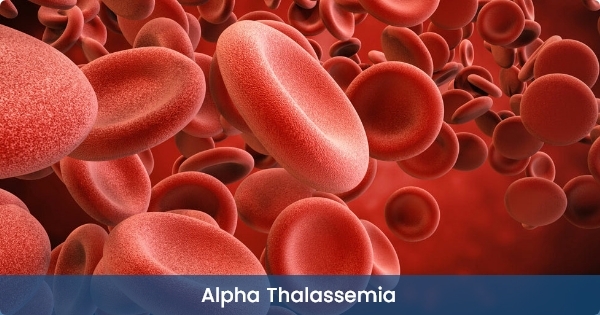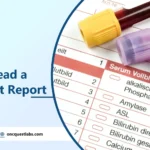Contents
- 1 Introduction of Alpha Thalassemia:
- 1.1 Who discovered alpha thalassemia?
- 1.2 Causes of Alpha Thalassemia:
- 1.3 Four Types of classification based alpha-globin genes:
- 1.4 Is alpha thalassemia a serious disease?
- 1.5 What is the normal range for thalassemia?
- 1.6 What is alpha vs B thalassemia?
- 1.7 Which hemoglobin is decreased in alpha thalassemia?
- 1.8 Alpha thalassemia symptoms:
- 1.9 How is alpha thalassemia being diagnosed?
- 1.10 Test of Alpha Thalassemia
- 1.11 References:
Introduction of Alpha Thalassemia:
- Alpha thalassemia is a blood disorder that reduces the production of hemoglobin.
- Hemoglobin is the iron rich protein in red blood cells that carries oxygen to cells throughout the body.
- It is the deficiency in the synthesis of alpha globin chain.
- Beta globin chains are not affected and are produced at a normal rate.
- It causes the shortage of red blood cells that cause anemia.
- 4 copies of the alpha globin gene where each gene where each gene is responsible for ¼ production of alpha globin.
- The condition is caused by mutations or deletions in the genes that produce alpha-globin chains.
Who discovered alpha thalassemia?
- Thomas Cooley is the first to describe thalassemia.
- Thalassemia is recognized as a genetic disease.
- Thalassemia is determined to be caused by an abnormal hemoglobin.
- The thalassemia mutation is found to protect against malaria.
Causes of Alpha Thalassemia:
- Gene mutations: Alpha thalassemia is primarily caused by mutations in the HBA1 and HBA2 genes, which are responsible for producing alpha-globin chains.
These mutations can disrupt the normal production of alpha-globin, leading to an imbalance in the production of alpha- and beta-globin chains.
- Gene deletions: In some cases, sections of the HBA1 and HBA2 genes may be deleted, resulting in a reduced or absent production of alpha-globin chains.
The severity of alpha thalassemia depends on the number of gene deletions present.
- Genetic inheritance: Alpha thalassemia is inherited in an autosomal recessive manner, meaning that an affected individual must inherit two mutated copies of the alpha-globin genes (one from each parent) to develop the disorder.
If a person inherits only one mutated copy, they are considered carriers of the condition but may not exhibit symptoms.
- Geographic prevalence: The prevalence of alpha thalassemia varies among different populations and geographic regions.
The condition is more commonly found in regions where malaria is or has been prevalent, such as Southeast Asia, sub-Saharan Africa, the Mediterranean, and the Middle East.
It is believed that the presence of certain alpha thalassemia gene mutations may confer some protection against malaria, leading to a higher frequency of these mutations in malaria-endemic regions.
Four Types of classification based alpha-globin genes:
Silent Carrier: This subtype generally does not cause any symptoms and individuals lead normal lives without any significant health issues.
Alpha Thalassemia Trait: Individuals with alpha thalassemia trait may have mild anemia, which is a condition characterized by a lower-than-normal number of red blood cells or a lower-than-normal amount of hemoglobin in the blood. Most people with alpha thalassemia trait do not require treatment and live normal lives without major complications.
Hemoglobin H Disease: This subtype is characterized by a moderate to severe form of anemia. People with hemoglobin H disease may experience symptoms such as fatigue, weakness, pale skin, and an enlarged spleen. Treatment may involve occasional blood transfusions, folic acid supplementation, and careful management of symptoms.
Alpha Thalassemia Major (also known as Hydrops Fetalis): This is the most severe form of alpha thalassemia. It is usually diagnosed before birth or shortly after. Babies with alpha thalassemia major often have life-threatening complications, such as severe anemia, organ failure, and fluid buildup in the body. Treatment often involves blood transfusions and other supportive measures, but it can be challenging, and the prognosis may be poor.
Is alpha thalassemia a serious disease?
Alpha thalassemia is a genetic disorder that affects the production of hemoglobin, the protein responsible for carrying oxygen in red blood cells. The severity of alpha thalassemia can vary depending on the specific subtype and the number of affected genes.
What is the normal range for thalassemia?
Thalassemia intermedia is characterized by Hb level between 7 and 10 g/dl, MCV between 50 and 80 fl and MCH between 16 and 24 pg.
What is alpha vs B thalassemia?
When thalassemia is called “alpha” or “beta,” this refers to the part of hemoglobin that isn’t being made. If either the alpha or beta part is not made, there aren’t enough building blocks to make normal amounts of hemoglobin. Low alpha is called alpha thalassemia. Low beta is called beta thalassemia.
Which hemoglobin is decreased in alpha thalassemia?
Hemoglobin is made of two alpha globins and two beta globins. In alpha thalassemia, the body makes less alpha globin than beta globin because of the gene mutation. The imbalance in alpha and beta globin causes anemia and leads to other medical problems from alpha thalassemia.
Alpha thalassemia symptoms:
The symptoms of alpha thalassemia can vary depending on the specific subtype and the severity of the condition. Here are the symptoms associated with the different subtypes:
Silent Carrier: Most individuals with silent carrier alpha thalassemia do not experience any symptoms. They usually have no significant health problems and lead normal lives.
Alpha Thalassemia Trait: People with alpha thalassemia trait may have mild symptoms or no symptoms at all. Some individuals may experience:
Mild anemia: This can cause fatigue, weakness, and pale skin.
Red blood cell abnormalities: There may be smaller and paler red blood cells than usual.
Hemoglobin H Disease: Hemoglobin H disease is characterized by moderate to severe anemia. Symptoms may include:
Fatigue and weakness, Pale or yellowish skin, Shortness of breath, Enlarged spleen. Bone deformities (in some cases) Poor growth and development (in children).
Alpha Thalassemia Major (Hydrops Fetalis): Alpha Thalassemia major is the most severe form and is usually diagnosed before birth or shortly after. Symptoms can be life-threatening and may include:
Severe anemia: This can lead to pale skin, extreme fatigue, and weakness. Enlarged liver and spleen. Abdominal swelling, Edema (fluid retention) in the body, including the arms, legs, and abdomen, Failure to thrive and poor growth in infant.
How is alpha thalassemia being diagnosed?
Alpha thalassemia is diagnosed through a combination of clinical evaluation, laboratory tests, and genetic analysis. The following are commonly used methods to diagnose alpha thalassemia:
Blood tests: A complete blood count (CBC) is often the initial step in diagnosing alpha thalassemia. It can reveal changes in red blood cell parameters, such as low hemoglobin levels (anemia), reduced mean corpuscular volume (MCV), and decreased mean corpuscular hemoglobin (MCH). Other blood tests, such as hemoglobin electrophoresis, can help differentiate alpha thalassemia from other types of anemia.
Genetic analysis: Genetic testing is crucial for confirming the diagnosis of alpha thalassemia and determining its specific type. It involves analyzing the alpha-globin genes (HBA1 and HBA2) to identify any genetic mutations or deletions. This can be done through various methods, including polymerase chain reaction (PCR), DNA sequencing, or DNA hybridization techniques.
Family history: A detailed family history can provide important clues, as alpha thalassemia is an inherited disorder. If there is a family history of alpha thalassemia or if the parents are carriers of the disease, genetic testing becomes even more relevant.
Prenatal testing: In some cases, prenatal testing may be recommended if there is a high risk of alpha thalassemia in the unborn child. This can be done through techniques like chorionic villus sampling (CVS) or amniocentesis, where a sample of fetal cells is obtained and analyzed for genetic abnormalities.
Test of Alpha Thalassemia
The diagnosis of alpha thalassemia involves a combination of clinical evaluation, family history assessment, and laboratory tests. Here are some of the common tests used for diagnosing alpha thalassemia:
Complete Blood Count (CBC): A CBC is a routine blood test that measures various components of the blood, including red blood cell count, hemoglobin levels, hematocrit, and mean corpuscular volume (MCV). In alpha thalassemia, the CBC results may show low levels of hemoglobin, smaller red blood cells, and decreased red blood cell count.
Hemoglobin Electrophoresis: This test is used to analyze the types and amounts of different hemoglobin variants present in the blood. It can help distinguish between various forms of thalassemia, including alpha and beta thalassemia. In alpha thalassemia, the electrophoresis results typically show decreased or absent alpha globin chains.
DNA Analysis: Genetic testing can be performed to identify specific mutations or deletions in the alpha globin genes. This type of testing can help confirm the diagnosis and determine the severity of the condition. It may involve techniques such as polymerase chain reaction (PCR) or DNA sequencing.
Fetal DNA Testing: In certain cases, prenatal diagnosis may be necessary to determine if a fetus has alpha thalassemia. This can be done through procedures such as chorionic villus sampling (CVS) or amniocentesis, which involve obtaining a sample of the developing fetus’s cells for genetic testing.
References:
https://medlineplus.gov/genetics/condition/alpha-thalassemia/
https://medlineplus.gov/genetics/condition/alpha-thalassemia/
https://www.ncbi.nlm.nih.gov/pmc/articles/PMC8565582/
https://kidshealth.org/en/parents/thalassemias.
https://kidshealth.org/en/parents/thalassemias.html


![Blood Test for Hair Loss [Male/Female] Blood Test for Hair Loss](https://oncquest-blog.s3.ap-south-1.amazonaws.com/blog/wp-content/uploads/2023/12/12044200/Blood-Test-for-Hair-Loss.webp)


